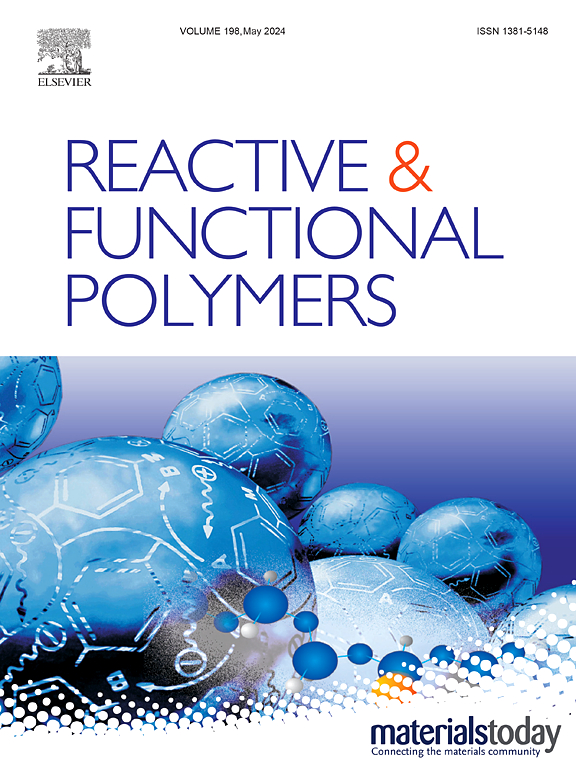The effect of coordination state on the activity of TA-Zr supramolecular networks for heavy metals removal from water
IF 4.5
3区 工程技术
Q1 CHEMISTRY, APPLIED
引用次数: 0
Abstract
The self-assembly behavior of the MPNs-based adsorbent is substantially influenced by changes in solution pH. In this study, a highly negatively charged tannic acid‑zirconium (TA-Zr) macromolecular network has been successfully synthesized. As pH increases from 3 to 11, the coordination structure of TA with Zr(IV) changes from mono- to tri-complexation state, resulting in enhanced electronegativity and increased structural stability of tri-complex TA-Zr(9) due to its higher charge density. The TA dissolution experiments and zeta potential measurements confirm this conclusion. The tri-complex TA-Zr(11) underwent structural changes in its macromolecular network due to partial zirconium hydroxide formation under strongly alkaline conditions, as confirmed by X-ray photoelectron spectroscopy analysis, which in turn impacted its stability. Meanwhile, the adsorption capacity of TA-Zr materials for Pb(II) ion increases with the pH of the synthesis solution. XPS analysis suggested that the underlying adsorption mechanism involved ligand exchange between Pb(II) ion and phenolic hydroxyl groups on TA-Zr(9). After batch adsorption-regeneration cycles, TA-Zr(9) could be regenerated with an acidic solution while maintaining consistent Pb(II) ion removal efficiency. Furthermore, TA-Zr(9) effectively treated 12,150 bed volumes (BV) of synthetic water at pH 5.6, which is 18 times more than commercial D001. These results confirm that TA-Zr(9) shows great potential as an effective adsorbentfor Pb(II) removal in practical wastewater treatment, making it a promising candidate for water remediation.

配位态对TA-Zr超分子网络去除水中重金属活性的影响
基于mpns的吸附剂的自组装行为受到溶液ph变化的很大影响。在本研究中,成功合成了一个带高负电荷的单宁酸锆(TA-Zr)大分子网络。随着pH从3增加到11,TA与Zr(IV)的配位结构由单配位变为三配位,由于TA-Zr(9)的电荷密度增大,电负性增强,结构稳定性提高。TA溶出实验和zeta电位测量证实了这一结论。x射线光电子能谱分析证实,三配合物TA-Zr(11)在强碱性条件下,由于部分氢氧化锆的形成,其大分子网络发生了结构变化,从而影响了其稳定性。同时,TA-Zr材料对Pb(II)离子的吸附能力随着合成溶液pH的增大而增大。XPS分析表明,TA-Zr(9)的潜在吸附机制涉及Pb(II)离子与酚羟基之间的配体交换。经过间歇吸附-再生循环,TA-Zr(9)可以在酸性溶液中再生,同时保持一致的Pb(II)离子去除效率。此外,TA-Zr(9)在pH 5.6下有效处理了12150床体积(BV)的合成水,是商业D001的18倍。这些结果证实了TA-Zr(9)在实际废水处理中作为一种有效的Pb(II)吸附剂具有很大的潜力,使其成为水修复的有希望的候选者。
本文章由计算机程序翻译,如有差异,请以英文原文为准。
求助全文
约1分钟内获得全文
求助全文
来源期刊

Reactive & Functional Polymers
工程技术-高分子科学
CiteScore
8.90
自引率
5.90%
发文量
259
审稿时长
27 days
期刊介绍:
Reactive & Functional Polymers provides a forum to disseminate original ideas, concepts and developments in the science and technology of polymers with functional groups, which impart specific chemical reactivity or physical, chemical, structural, biological, and pharmacological functionality. The scope covers organic polymers, acting for instance as reagents, catalysts, templates, ion-exchangers, selective sorbents, chelating or antimicrobial agents, drug carriers, sensors, membranes, and hydrogels. This also includes reactive cross-linkable prepolymers and high-performance thermosetting polymers, natural or degradable polymers, conducting polymers, and porous polymers.
Original research articles must contain thorough molecular and material characterization data on synthesis of the above polymers in combination with their applications. Applications include but are not limited to catalysis, water or effluent treatment, separations and recovery, electronics and information storage, energy conversion, encapsulation, or adhesion.
 求助内容:
求助内容: 应助结果提醒方式:
应助结果提醒方式:


